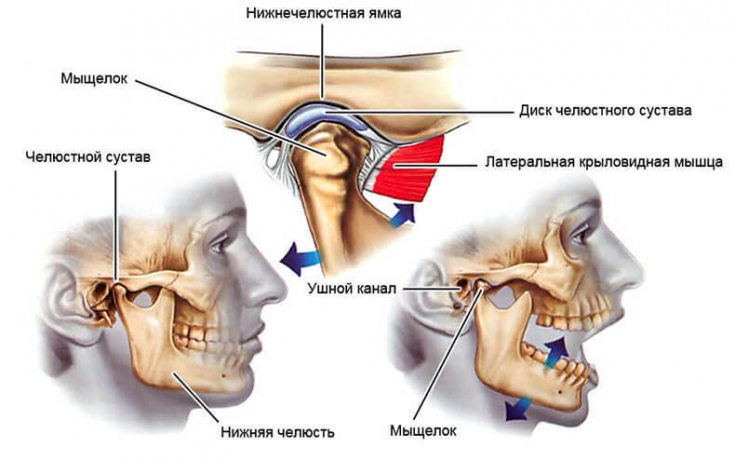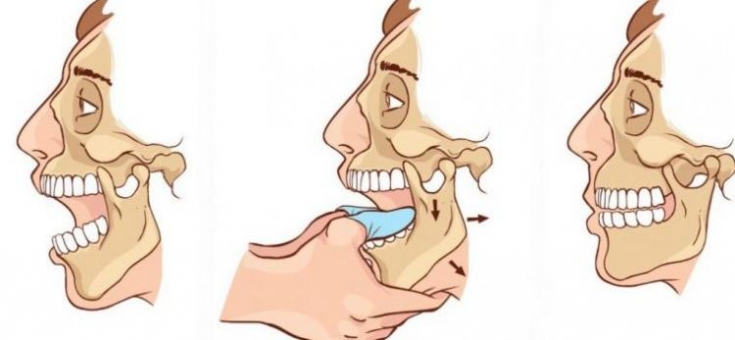Dislocation of the temporomandibular joint is about 5.5% of the total number of dislocations that occur in traumatology. In most cases, the dislocation of the lower jaw occurs due to its sharp movement: when chewing, yawning, or on the form of injury.
Each doctor should know a simple algorithm of therapeutic measures that should be provided to a patient with a dislocation of the temporomandibular joint.
For more information on how to recognize the anterior and posterior types of mandibular dislocation, as well as how to help a patient with a dislocation, read on estet-portal.com in this article.
Anatomy of the temporomandibular joint: structural features
Temporomandibular joint – combined joint, formed by the mandibular fossa of the temporal bone and the head of the mandibular bone. The structure of the temporomandibular joint also includes an intra-articular cartilaginous disc. It adheres to the joint capsule.
Movement in the temporomandibular joint can be performed in three directions: frontal, sagittal and vertical planes.
The range of motion in the temporomandibular joint is limited by the ligaments that strengthen it: the greater lateral ligament, the sphenoid-maxillary ligament, and the stylomandibular ligament.
A dislocation occurs when, after opening the mouth, the head of the mandibular bone protrudes too far forward, getting stuck behind the articular tubercle of the temporal bone, and cannot return back. This often happens due to weakening and overstretching of the ligaments of the temporomandibular joint.

Temporomandibular joint dislocation: symptoms of anterior dislocation
Temporomandibular joint dislocation can occur spontaneously or in combination with jaw trauma, dental examinations, and even during yawning.
In most cases, dislocation of the temporomandibular joint – one-sided, but there may be two-sided dislocation.
Anterior dislocation of the temporomandibular joint is more common. In this case (both in the case of unilateral and bilateral), the patient's mouth is open, he cannot close it. The dislocation of the lower jaw is accompanied by severe pain in the temporomandibular joint, slurred speech, hypersalivation.
Follow us on Instagram
Temporomandibular joint dislocation: posterior jaw dislocation
In a posterior temporomandibular joint dislocation, the patient is unable to open his or her mouth. Objectively, there is a posterior displacement of the chin, the lower incisors rest against the hard palate. Palpation of the head of the lower jaw is determined in the region of the mastoid process.
The patient takes a forced position with the head tilted forward. There is severe pain in the parotid areas. When the lower jaw is displaced, damage to the bone wall of the external auditory canal may occur, as a result of which bleeding develops.
Xerostomia: Causes and Treatments for Dry Mouth
Temporomandibular joint dislocation: treatment algorithm
A doctor of any specialty must know a simple algorithm of therapeutic measures, which should first of all be provided to a patient with a dislocation of the temporomandibular joint.

In case of mandibular dislocation, you must:
1. place the patient in a sitting position. If the doctor has an assistant, he should stand behind the patient and support his head. You can try to relax the chewing muscles of the patient by gently massaging the cheeks;
2. Reset the dislocation: place the thumb fingers as deep as possible in the patient's mouth behind the molars. The remaining fingers should hold the jaw. Firmly press the thumbs and move the lower jaw down until the muscles snap the joint back into the correct position. Reduction of the joint is accompanied by a characteristic click.
A doctor of any specialty should know a simple algorithm of therapeutic measures that should be provided to a patient with a dislocation of the temporomandibular joint.
If the reduction of the temporomandibular joint is unsuccessful, it is necessary to seek help from a specialist - maxillofacial surgeon on the same day.
Thank you for staying with estet-portal.com. Read other interesting articles in the "Dentistry" section. You may also be interested in: Acute Toothache: Fast Professional Patient Care







Add a comment